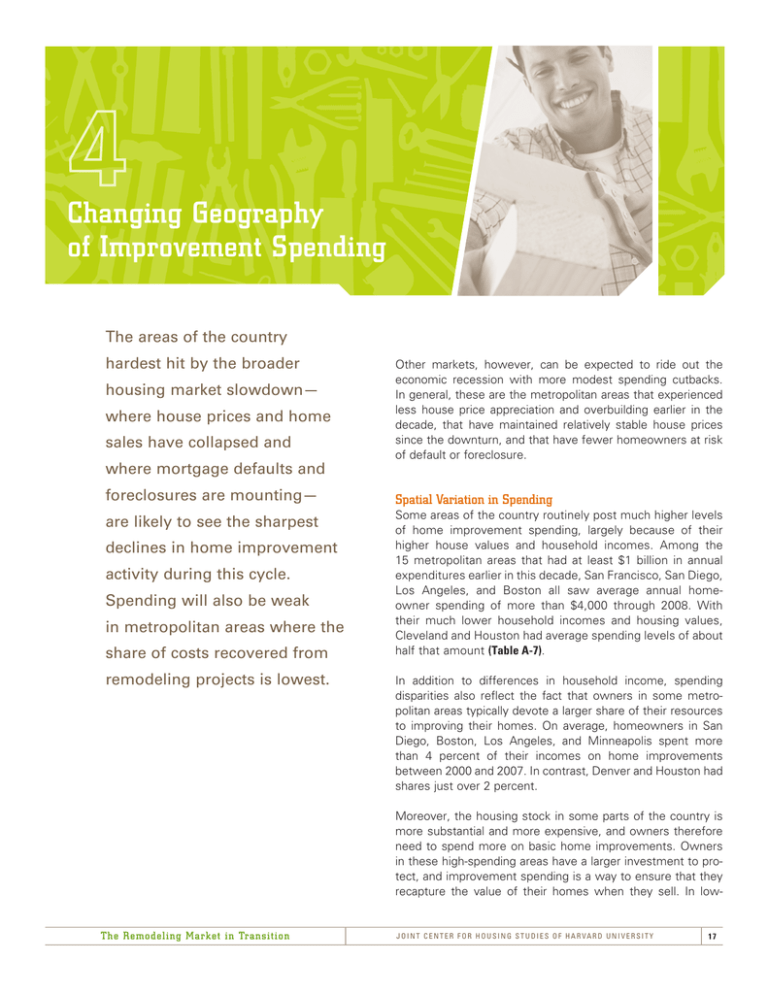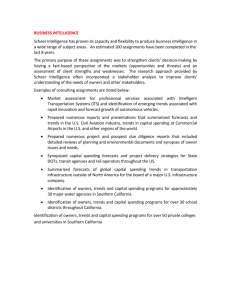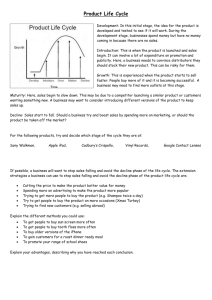Changing Geography of Improvement Spending The areas of the country
advertisement

Changing Geography of Improvement Spending The areas of the country hardest hit by the broader housing market slowdown— where house prices and home sales have collapsed and where mortgage defaults and foreclosures are mounting— are likely to see the sharpest declines in home improvement activity during this cycle. Spending will also be weak in metropolitan areas where the share of costs recovered from remodeling projects is lowest. Other markets, however, can be expected to ride out the economic recession with more modest spending cutbacks. In general, these are the metropolitan areas that experienced less house price appreciation and overbuilding earlier in the decade, that have maintained relatively stable house prices since the downturn, and that have fewer homeowners at risk of default or foreclosure. Spatial Variation in Spending Some areas of the country routinely post much higher levels of home improvement spending, largely because of their higher house values and household incomes. Among the 15 metropolitan areas that had at least $1 billion in annual expenditures earlier in this decade, San Francisco, San Diego, Los Angeles, and Boston all saw average annual homeowner spending of more than $4,000 through 2008. With their much lower household incomes and housing values, Cleveland and Houston had average spending levels of about half that amount (Table A-7). In addition to differences in household income, spending disparities also reflect the fact that owners in some metropolitan areas typically devote a larger share of their resources to improving their homes. On average, homeowners in San Diego, Boston, Los Angeles, and Minneapolis spent more than 4 percent of their incomes on home improvements between 2000 and 2007. In contrast, Denver and Houston had shares just over 2 percent. Moreover, the housing stock in some parts of the country is more substantial and more expensive, and owners therefore need to spend more on basic home improvements. Owners in these high-spending areas have a larger investment to protect, and improvement spending is a way to ensure that they recapture the value of their homes when they sell. In low- The Remodeling Market in Transition J o i n t C e n t e r F o r H o u s i n g S t u d i e s o f H a r va r d U n i v e r s i t y 17 Figure 16 Home Improvement Spending in the Midwest and Texas Should Decline the Least in the Near Term Metropolitan areas with smallest declines in house prices and sales Buffalo � San Francisco � Cleveland � Pittsburgh � Indianapolis � � Sacramento � San Jose Rochester � Philadelphia St. Louis � � Smallest Price Decline � Smallest Sales Decline Nashville � Los Angeles � � Charlotte San Diego � Dallas � Smallest Price Decline and Smallest Sales Decline Notes: Sample includes the 50 largest metropolitan an areas defined by total housing units. Declines in sales and median prices of existing ting single-family homes are measured from their most recent peak to 2008:3. Declines in sales range from 0% to 23%, while declines in prices range from 0% % to 4%. Source: Table A-5. Austin � San Antonio � spending areas, owner improvements may not be as effective in increasing home values, particularly if other owners in the area do not upgrade as well. Fallout from the Housing Market Crisis As home prices soared over the past decade, owners saw the equity they held in their homes climb rapidly. With this strong surge in household wealth, homeowners did not hesitate to tap their equity through loans or by taking cash out at the time of sale or mortgage refinancing. Indeed, owners extracted an average of $450 billion a year from their homes. According to recent studies by the Federal Reserve Board, owners then reinvested more than one-quarter of the equity withdrawn in home improvements. Now with prices plunging, the amount of equity that owners have in their homes has also plummeted—so much so that a growing number of owners have mortgage balances that exceed the value of their homes. Soft house prices provide owners little incentive to invest in home improvements, and many choose to wait until the market bottoms out before making their spending decisions. Would-be sellers and buyers who would otherwise invest in improvements are also on the sidelines. Households that want to sell typically make cosmetic improvements before The Remodeling Market in Transition Houston placing their homes on the market. Buyers often make much more substantial changes at the time of purchase for a variety of reasons: they can more readily obtain improvement financing in conjunction with the principal mortgage; they may be able to delay their move-in date until after the work is completed and therefore avoid significant disruption; and they can enjoy the upgrades for the entire time they own their homes. Since recent homebuyers spend about 23 percent more on improvements than similar owners who do not move, fewer home sales mean lower remodeling expenditures. Indeed, the nationwide drop in sales translates into about a $2 billion cutback in home improvement spending. But metropolitan areas where house price and sales declines have been modest should see less of a slowdown in home improvement activity over the next several quarters. Many of these metros, which are concentrated in the industrial Midwest, did not experience a rapid run-up in prices and therefore have not posted such a dramatic drop-off (Figure 16). Several Texas metro areas have also managed to avoid some of the recent economic turmoil, and home prices and sales have held up reasonably well. Finally, sales in some previously overheated markets such as Los Angeles, San Diego, and San Francisco have already begun to revive from their dramatic collapse beginning in early 2004. J o i n t C e n t e r F o r H o u s i n g S t u d i e s o f H a r va r d U n i v e r s i t y 18 Figure 17 Previously Overheated Coastal Markets Face Sharply Lower Home Prices and Sales Metropolitan areas with largest declines in house prices and sales Seattle � Portland � � Hartford San Francisco � Chicago � � Sacramento � Baltimore � Washington � Las Vegas Los Angeles � � Largest Price Decline � Riverside San Diego � � Phoenix � Largest Sales Decline Memphis � Birmingham � Largest Price Decline and Largest Sales Decline Notes: Sample includes the 50 largest metropolitan an areas defined by total housing units. Declines in sales and median prices of existing ting single-family homes are measured from their most recent peak to 2008:3. Declines in sales range from 47% to 63%. Declines in prices range from 25% too 46%. Source: Table A-5. In the near term, the largest declines in improvement spending will be in metropolitan areas where home sales and prices have retreated the most. The markets with the largest declines in prices are primarily in Florida, California, and other rapidly growing Southwest metros (Figure 17). Areas with the largest declines in sales, however, are much more geographically dispersed. In some instances, these two indicators of future home improvement activity are sending conflicting signals. For example, San Diego, San Francisco, and Los Angeles—recently among the most rapidly appreciating housing markets in the country—have posted some of the smallest declines in sales and the largest declines in prices. Growing sales of distressed properties are the explanation. According to DataQuick estimates, 52 percent of existing home sales in San Diego County in November 2008 were of properties foreclosed in the previous year, as were 44 percent in the San Francisco Bay area, and 44 percent in Los Angeles County. Since house prices are largely determined by what households can afford to pay, the ratio of house prices to incomes is an effective indicator of future price adjustments. Between 1975 and 2000, house prices nationally averaged about 1.7 times household income, with very little year-to-year variation around this trend. Beginning around 2000, house prices began to climb faster than incomes, peaking at the end of 2006 at The Remodeling Market in Transition Tampa � Orlando Miami more than 2.1 times household incomes. By the third quarter of 2008, this ratio had dropped back to 1.9. This national analysis masks the tremendous variation in local house-price­­-to-income ratios. In areas such as Cleveland, the relationship between prices and household incomes has been fairly stable, implying that little adjustment is necessary (Figure 18). At the other extreme is San Francisco, where house prices have historically run at more than three times household income. As a result, while some adjustment in prices is still ahead, San Francisco’s ratio is unlikely to fall to national averages. In between these extremes are metros such as New York, where house prices have moderated somewhat but further adjustment is likely, and Dallas, where the ratio has held near normal levels since the run-up in house prices in the 1980s. The Pressure from Foreclosures For a growing number of owners, house price declines have already eliminated all of the equity they held in their homes. Moody’s Economy.com put the share of owners with mortgage balances that exceed the market value of their homes at 15–20 percent in the third quarter of 2008. Owners with little or no equity in their homes that also face financial pressures—such as an upwardly adjusting interest rate on a subprime home loan or an employment loss—are J o i n t C e n t e r F o r H o u s i n g S t u d i e s o f H a r va r d U n i v e r s i t y 19 Figure 18 House-Price-to-Income Ratios Normally Vary Greatly Across Metro Areas Median existing single-family house price compared with mean household income 6 5 4 3 2 1 � New York � 2007:1 2005:1 2003:1 2001:1 1999:1 1997:1 1995:1 1993:1 � 1991:1 San Francisco 1989:1 1987:1 Dallas 1985:1 � 1983:1 Cleveland 1981:1 1977:1 � 1979:1 1975:1 0 National Note: House price is the 2008:3 median sales price of existing single-family homes as determined by NAR and indexed by the Freddie Mac Conventional Mortgage Home Price Index. Sources: Freddie Mac; Bureau of Economic Analysis; US Census Bureau; NAR; and Moody's Economy.com. especially at risk of default and ultimately foreclosure. Loans entering foreclosure averaged 4.8 percent of all mortgages nationally between 2007 and the first half of 2008, according to US Department of Housing and Urban Development estimates. Foreclosure rates are currently highest in California, Nevada, and Florida—states where house price appreciation was rapid earlier in the decade and where markets were often overbuilt. Certain states in the industrial Midwest also have high foreclosure rates thanks to weak economies and falling household incomes (Figure 19). High levels of distressed properties in general, and of foreclosures in particular, push down home improvement spending. Owners with little equity and threatened with default are unlikely to make significant improvements to their homes. But even more important is the impact of foreclosed homes on the improvement decisions of neighboring property owners. Homeowners that see growing numbers of vacant properties in their area may fear a decline in market values and therefore hesitate to make improvements to their own homes. During the past decade, the reverse of this phenomenon was an important driver of home improvement spending. As house values began to rise, homeowners would use their growing equity to make improvements, which not only increased the value of their homes but also generally increased home values throughout their communities. Rising house values in a community, in turn, produced higher levels of home equity, which encouraged more home improvement activity. In a recent The Remodeling Market in Transition study, Joint Center researchers found that for a given level of improvement expenditures, house price appreciation was 15 percent higher if the home was located in a neighborhood with above-average improvement spending, as compared with a neighborhood with below-average spending. In all likelihood, the opposite dynamic is now playing out in many neighborhoods. As spending on distressed and foreclosed properties stalls, nearby property values are declining. As house prices in the neighborhood fall, owners of nondistressed homes have less equity to undertake improvements. With lower levels of improvement spending, prices slide even further. Weakening Project Cost Recovery Owners undertake some types of home improvements to increase the enjoyment of their homes and to keep them operating efficiently, such as replacing floor and wall coverings, modernizing equipment and appliances, and retrofitting aging systems. Other projects, however, are considered investments that enhance the home’s appeal in the market and thereby increase its value. For any given home improvement project, the amount of the cost that the owner recaptures in the form of higher market value depends heavily on local house price appreciation. In general, when house prices are increasing, owners recoup a larger share of the cost because the value of that improvement rises along with house prices. J o i n t C e n t e r F o r H o u s i n g S t u d i e s o f H a r va r d U n i v e r s i t y 20 Figure 19 Home Foreclosures Are Heavily Concentrated in California, Florida, and the Industrial Midwest Estimated share of mortgages entering foreclosure between January 2007 and June 2008 (Percent) Foreclosure osure Rate � � � � � Under der 2.0% 2.0–3.9% –3.9% 4.0–5.9% –5.9% 6.0–7.9% –7.9% 8.0% % or Higher Source: USS Department of Housing and Urban Development, Neighborhood Stabilization Program. Figure 20 Rapidly Appreciating Markets that Saw the Highest Cost Recovery Earlier in the Decade Are Now Experiencing the Sharpest Declines Average share of improvement costs recovered (Percent) 110 100 102 90 85 80 76 70 74 65 60 67 50 When annual house price appreciation peaked at 12.8 percent nationally in 2005, the recapture rate for home improvement projects reached 86.7 percent across the metro areas surveyed by Remodeling magazine and the National Association of Realtors®. When house price gains slowed to just 2.0 percent in 2006, however, the average cost recovery dropped to 76.1 percent. As house prices continued to slip, the share fell to 70.0 percent in 2007 and then to 67.2 percent in 2008. These national trends help to explain the relationship between local house price appreciation and home improvement spending. In metropolitan areas where house price appreciation was strongest between 2001 and 2005, owners captured more than 100 percent of their costs in 2005 (Figure 20). By comparison, metro areas with moderate house price appreciation recouped an average of 85 percent of project costs, while those with low appreciation recouped just 76 percent. 40 Low Moderate High Metro Area House Price Appreciation, 2001–2005 � 2005 � 2008 Notes: Sample includes 41 metropolitan areas in Remodeling magazine’s Cost vs. Value survey between 2005 and 2008 that had at least 10 survey responses in each year. Appreciation categories include a similar number of metros. Source: Table A-6. The Remodeling Market in Transition As house prices continue to decline and economic conditions deteriorate, this trend is reversing. Most of the top 10 metropolitan areas in terms of house price declines report much lower cost recovery for home improvement projects, with the average share down by 28 percentage points between 2005 and 2008. In Washington, DC, for example, the share of project costs recovered shrank from an average of 114.3 percent in 2005 to 63.6 percent in 2008; in Miami, from 118.1 percent to 83.3 percent; in San Francisco, from 126.8 J o i n t C e n t e r F o r H o u s i n g S t u d i e s o f H a r va r d U n i v e r s i t y 21 percent to 93.2 percent; and in Phoenix, from 106.3 percent to 77.2 percent (Table A-6). Pockets of Spending Strength Although beginning to fall nationally in 2007, house prices in some markets continued to appreciate and owners therefore continued to spend on improvements. Even with the backdrop of a troubled economy and soaring home foreclosures, these households reported expenditures about 30 percent above the national average (Figure 21). At the same time, owners in markets with declining home values reported home improvement expenditures about 30 percent below the national average. It should be noted that owners are often slow to comprehend how much their homes may have lost in value and thus may either overstate price appreciation or understate the magnitude of the decline. The pattern is, however, unmistakable: owners who felt that the prices of their homes were holding up continued to spend much more on home improvements than those who felt their homes were dropping in value. The Outlook As the housing market correction proceeds, the metropolitan areas with the largest inventory overhangs will likely see the steepest declines in home improvement spending. The growing number of properties with delinquent and foreclosed mortgages is accelerating the adjustment process. As banks and other investors attempt to clean up their balance sheets, they are cutting prices on foreclosed homes to stimulate sales. Meanwhile, owners of distressed properties are cutting back on their improvement spending. As the number of households unwilling or unable to take on projects continues to grow, nearby owners will remain reluctant to invest in their own homes out of concern for falling prices. Nevertheless, metropolitan areas that did not experience excessive house price appreciation earlier in the decade and that have strong enough economies to support modest growth in the coming quarters should be able to maintain healthy levels of home improvement spending. Areas where house prices are still declining can expect to see improvement spending rebound once prices reach bottom. Figure 21 Homeowners in Appreciating Markets Continue to Spend on Remodeling Average annual improvement spending (Dollars) 4,500 4,000 $4,240 3,500 $3,590 3,000 $3,050 2,500 2,000 $2,110 $2,150 More than 10% Decline 0–10% Decline $2,370 1,500 1,000 500 0 Flat (0–5%) 5–15% Increase More than 15% Increase All Owners Average Annual House Price Change, 2005–2007 Source: JCHS tabulations of the 2005–2007 AHS. The Remodeling Market in Transition J o i n t C e n t e r F o r H o u s i n g S t u d i e s o f H a r va r d U n i v e r s i t y 22




